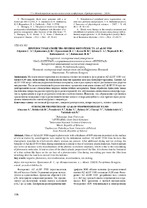| dc.contributor.author | Абрамов, С. А. | ru |
| dc.contributor.author | Бринкевич, Д. И. | ru |
| dc.contributor.author | Просолович, В. С. | ru |
| dc.contributor.author | Колос, В. В. | ru |
| dc.contributor.author | Зубова, О. А. | ru |
| dc.contributor.author | Черный, В. В. | ru |
| dc.contributor.author | Вабищевич, С. А. | ru |
| dc.contributor.author | Вабищевич, Н. В. | ru |
| dc.coverage.spatial | Минск | ru |
| dc.date.accessioned | 2025-02-05T12:15:49Z | |
| dc.date.available | 2025-02-05T12:15:49Z | |
| dc.date.issued | 2024 | |
| dc.identifier.citation | Прочностные свойства пленок фоторезиста AZ nLOF 5510 = Strength properties of AZ nLOF 5510 photoresist films / С. А. Абрамов, Д. И. Бринкевич, В. С. Просолович [и др.] // Приборостроение-2024 : материалы 17-й Международной научно-технической конференции, 26-29 ноября 2024 года, Минск, Республика Беларусь / редкол.: А. И. Свистун (пред.), О. К. Гусев, Р. И. Воробей [и др.]. – Минск : Интегралполиграф, 2024. – С. 106-108. | ru |
| dc.identifier.uri | https://rep.bntu.by/handle/data/153025 | |
| dc.description.abstract | Методом индентирования исследованы пленки негативного фоторезиста AZ nLOF 5510 толщиной 0,99 мкм, нанесенные на поверхность пластин кремния методом центрифугирования. Пленки AZ nLOF 5510 ведут себя как упругопластичные материалы, в которых присутствуют растягивающие упругие напряжения. После дополнительной сушки и ионного травления поведение пленок AZ nLOF 5510 при индентировании схоже с поведением твердых непластичных материалов. Такая обработка приводила также увеличению микротвердости структур фоторезист/кремний, что обусловлено сшиванием молекул фоторезиста, приводящим к утрате упругопластических свойств пленки. Показано, что образование при ионном травлении на поверхности фоторезистивной пленки тонкого углеродоподобного слоя препятствует растяжению пленки после снятия нагрузки с индентора. | ru |
| dc.language.iso | ru | ru |
| dc.publisher | Интегралполиграф | ru |
| dc.title | Прочностные свойства пленок фоторезиста AZ nLOF 5510 | ru |
| dc.title.alternative | Strength properties of AZ nLOF 5510 photoresist films | ru |
| dc.type | Article | ru |
| local.description.annotation | Films of AZ nLOF 5510 negative photoresist with a thickness of 0.99 microns deposited on the surface of silicon wafers by centrifugation were studied by the indentation method. AZ nLOF 5510 films be-have like elastoplastic materials in which tensile elastic stresses are present. After additional drying and ion etching, the behavior of AZ nLOF 5510 films during indentation is similar to that of solid non-plastic materials. Such treatment also led to an increase in the microhardness of the photore-sist/silicon structures, which is due to the crosslinking of photoresist molecules. It lead to a loss of the elastic-plastic properties of the film. It is shown that the formation of a thin carbon-like layer on the sur-face of a photoresistive film during ion etching pre-vents the film from stretching after the load is re-moved from the indenter. | ru |

